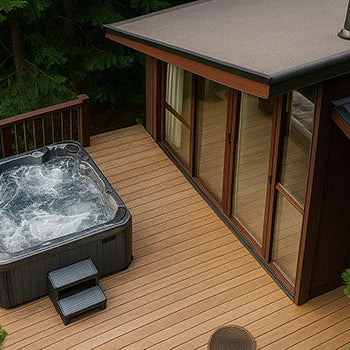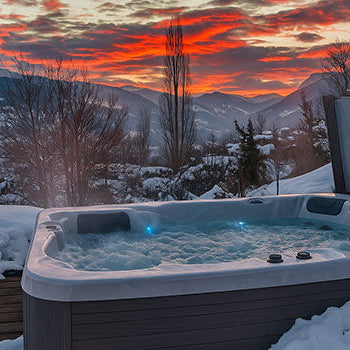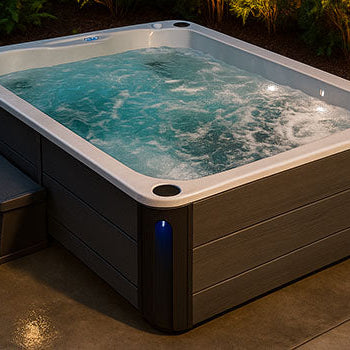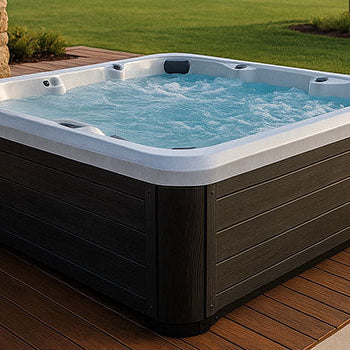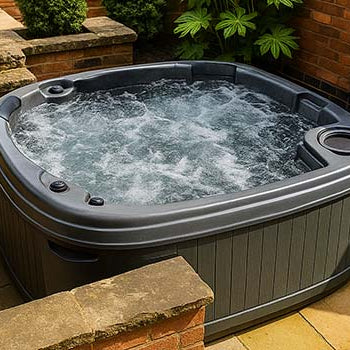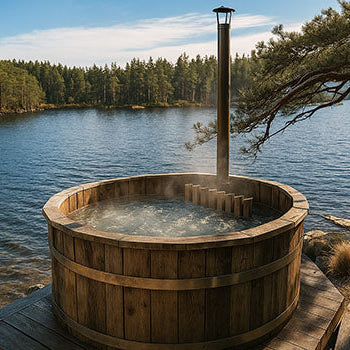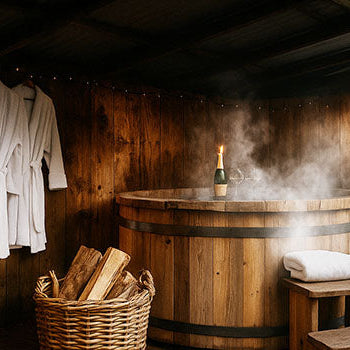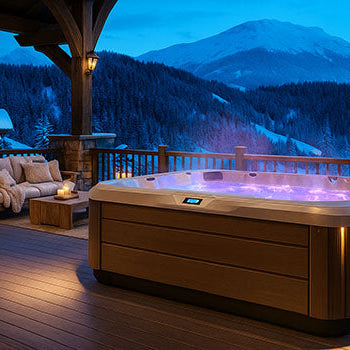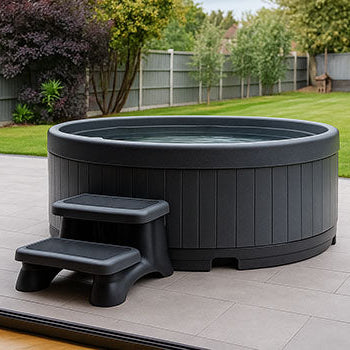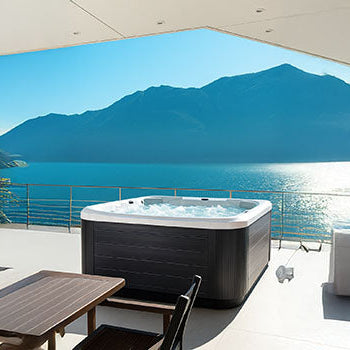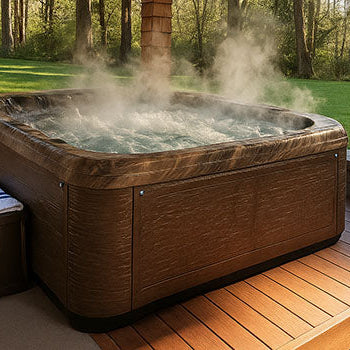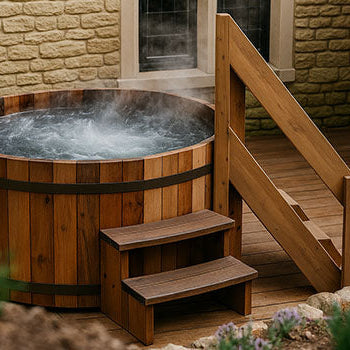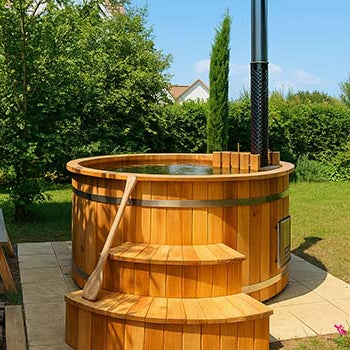Rainy skies, cuppa in hand, and your hot tub bubbling away in the garden, but is it okay to leave it out in the rain? Short answer: Yes, you can. Most modern tubs, including acrylic ones, rotomoulded types, and even classic wooden hot tubs, are made to handle the weather.
That said, a few smart precautions can make all the difference between a relaxing soak and an unexpected headache. Think of this guide as your rainy-day spa survival kit. Stick around and you’ll learn how to keep your hot tub happy, clean, and safe when the heavens open.

Are Hot Tubs Built to Withstand UK Weather?
Durable Materials Used for Outdoor Exposure
Hot tubs aren’t just for summer. The good ones are built for British weather, rain, cold, and all.
Acrylic hot tubs have UV resistance and solid shells, while rotomoulded versions are made from tough plastic that shrugs off water. Wooden hot tubs? As long as they're treated properly, they can stand their ground, too.
You’ll find insulation inside, reinforced bases, and finishes that help prevent waterlogging. Your spa is more weatherproof than your washing line.
Built-in Weather Resistance in Quality Models
The higher the quality, the more protection you’ll get.
Look out for sealed control panels, corrosion-resistant frames, and internal insulation that helps keep the elements out. Many models also come with waterproof cabinets and drainage built right in.
Manufacturers know you're not dragging your hot tub indoors every time it rains. They’ve done the hard work for you, so you can just enjoy the bubbles.
The Crucial Role of Your Hot Tub Cover in Wet Weather
Shielding the Acrylic Shell and Water Surface
Your cover is your hot tub’s first line of defence.
It stops rain from filling the shell and keeps leaves, insects, and other unwanted surprises out. That’s especially important for acrylic tubs, where standing water can cause grime to build up quickly.
Even if it’s drizzling, keeping the cover on when not in use helps you avoid extra cleanup later.
Minimising Rainwater Dilution of Chemicals
Rainwater might seem harmless, but it's a chemistry wrecker.
Every drop can dilute your sanitiser levels, meaning your chlorine or bromine won’t work as well. A secure cover helps keep the balance stable, so you’re not constantly playing catch-up with your test kit.
A well-fitted cover saves you money and hassle.
Helping Retain Heat During Cooler Rainy Periods
There’s nothing worse than stepping into lukewarm water on a chilly day.
Your cover traps heat, reducing your energy bills and keeping your soak steamy even when it’s tipping it down. Think of it like a big, fluffy jacket, only for your spa.
The Need for a Well-Fitting and Secured Cover
A cover that barely fits is like an umbrella with holes.
Choose one that hugs the shell tightly and locks into place. Covers with strong straps or clips stay put in windy rainstorms and stop water from sneaking in around the edges.
If your current cover is sagging or waterlogged, it might be time for an upgrade.

How Rain Can Affect Your Hot Tub's Water Balance
Potential Dilution of Sanitisers (Chlorine/Bromine)
Rain adds fresh water, which seems harmless, until it messes with your sanitiser.
Weaker chlorine or bromine levels mean bacteria can thrive, even if your water looks clean. After heavy rain, always test and adjust your chemicals.
Better safe than soaking in soup.
Lowering pH and Total Alkalinity Levels
Rain doesn’t just dilute, it changes your water’s personality.
Acid rain can lower your pH and alkalinity, making water uncomfortable and harder to balance. The result? Cloudy water, scaling, or irritated skin.
Regular testing keeps everything in check, even after just a short shower.
When to Test Water Chemistry After Heavy Rainfall
Got caught in a downpour? Don’t wait.
Check your water chemistry as soon as you can, ideally the same day. The faster you test, the easier it is to bring your water back to balance.
This is especially true if you own a smaller tub where rain makes a bigger splash.
Safety Considerations for Using Your Hot Tub During Rain
Is It Safe to Soak While It's Raining? (Generally Yes)
A drizzle while soaking? Absolute bliss.
It’s generally safe to enjoy your hot tub in light rain, as long as everything is correctly installed and protected. Many people even find it more relaxing.
Just keep your head dry and your GFCI protected.
Increased Slip Hazards on Surrounding Surfaces
Rain makes everything slippery, including steps and decking.
Add non-slip mats, grab rails, or wear water shoes when walking around the spa. A relaxing soak shouldn’t end in a cartoon-style tumble.
Check your surfaces regularly to prevent algae or moss buildup that adds to the risk.
Maintaining Electrical Safety (Importance of Proper Installation)
Electricity and water don’t mix.
That’s why your hot tub should be installed by a certified professional using RCD protection (like a GFCI) and weatherproof cabling. Never soak if you spot exposed wires or waterlogged panels.
If something feels off, switch it off and call an expert.
What About Severe Weather Like Thunderstorms?
Keeping the Cover Securely Fastened
Wind and rain? Your cover needs backup.
Always fasten straps tightly before a storm hits. If your cover lifts, rain will pour in, and debris can fly into the water. Worse still, the wind might carry your cover away entirely.
Treat it like securing garden furniture, better safe than soggy.
Why You Should Avoid Using the Hot Tub During Lightning
Lightning and hot tubs are a hard no.
Water conducts electricity, and if lightning strikes nearby, it could travel through the ground or water supply. It’s just not worth the risk.
If you hear thunder, get out, dry off, and wait for clear skies.
Benefits of Additional Shelter (Gazebo, Canopy)
A little extra cover can go a long way.
Adding a gazebo or pergola protects your spa and your cover from wear and tear, and gives you a dry entry point on rainy days. It also adds a bit of luxury and privacy to your outdoor space.
Bonus: it helps your hot tub look like the star of your garden.

Conclusion: Your Hot Tub is Fine in the Rain (But Your Cover is Key)
So here’s the takeaway: your hot tub is made to handle the rain, but your cover and your care routine are what keep it running smoothly.
Acrylic, rotomoulded, and wooden tubs all have their strengths, but none of them enjoy untreated rainwater soaking in.
Check your chemistry, secure your electrics, and keep that cover locked down.
With a little attention and the right setup, your hot tub can be your rainy-day retreat, not a repair waiting to happen.
